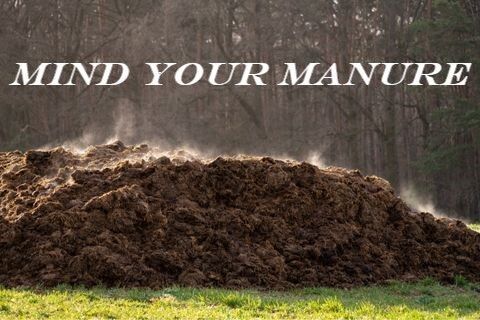
Manure management is a year round process, however winter weather and freezing temperatures can limit acceptable application days. It is important to follow USDA guidelines when applying manure, both on the surface of fields and incorporating manure into the soil, to prevent environmental concerns. Frozen or snow covered ground increases the risk for manure runoff and can cause serious damage to streams and water quality. Next time you are planning to apply manure check out this helpful applicators forecaster at https://agri.ohio.gov/divisions/plant-health/resources/ohio-applicator-forecast.
Can I Spread Manure in the Winter When the Ground is Frozen or Snow Covered?
We get this question a lot, so… can you? The answer, it depends. Generally speaking, surface manure applications (applications where the manure is not incorporated into the soil) on frozen and/or snow-covered ground are discouraged and considered “not acceptable” under current USDA guidelines. These conditions provide a serious risk of runoff. Additionally, there is a risk of runoff when the top 2 inches of soil are saturated and when there is greater than a 50% chance of rainfall of more than 0.5” within 24 hours of the time of application. Those same guidelines become the default standard for acceptable management of livestock wastes under the Ohio Agricultural Pollution Abatement Program (think agricultural water pollution) rules. For the sake of this discussion, soil is considered “frozen” if the manure cannot be injected or immediately incorporated.
In the case of solid manures, the guidance is that the manure will not be surface applied in these conditions and should be stockpiled on an acceptable site until it can be applied for the next growing season. For liquid manure, winter applications are still considered “not acceptable” and discouraged in all but emergency situations. An “emergency” exists as a temporary situation due to unforeseen causes and after all other options have been exhausted.
If you must make emergency winter manure applications, follow the accepted best management practices for the situation. In this situation only limited quantities of liquid manure shall be applied to address manure storage limitations until non frozen soils are available for manure application. In Ohio, those accepted best management practices can be found in the USDA-NRCS Nutrient Management Standard (590). They are: (in part)
- 200-foot setback from grassed waterways, streams, drainage ditches, tile surface inlets and all other water bodies and 300 feet from developed springs, wells and public surface drinking water intakes. In certain instances, these set-backs may need to increased.
- At least 90 percent surface residue cover
- Apply manure to areas of the field with the lowest risk of nutrient transport such as areas furthest from streams, ditches, waterways, with the least amount of slope.
- For fields exceeding 6% slope manure shall be applied in alternating strips 60 to 200 feet wide generally on the contour, or in the case of contour strips on the alternating strips.
- Limited application rate –
- 5,000 gallons or, next crop need/removal for P, whichever is less.
- Do not apply on more than 20 contiguous acres. Contiguous areas must be separated by breaks of at least 200 feet.
All applications of liquid manure to frozen and snow-covered soils should be documented in the producer’s records. As always, the 4R’s (Rate, Time, Source and Placement) of all nutrient applications applies anytime nutrients are applied. If you have specific questions about how these best management recommendations relate to your field or operation, please call your local SWCD office.

For more information follow the link for factsheets and news articles related to manure and manure management,
Fact Sheets
https://ohioline.osu.edu/factsheet/AGF-212
https://ohioline.osu.edu/factsheet/anr-55
https://ohioline.osu.edu/factsheet/ANR-21
https://soilhealthinstitute.org/app/uploads/2022/01/Safferman-Data-Brief.pdf
Articles
https://agcrops.osu.edu/newsletter/corn-newsletter/2022-15/using-manure-corn
https://agcrops.osu.edu/newsletter/corn-newsletter/2022-08/early-season-manure-application
https://agcrops.osu.edu/newsletter/corn-newsletter/2022-06/topdressing-wheat-liquid-swine-manure
https://agcrops.osu.edu/newsletter/corn-newsletter/2019-01/winter-application-manure


